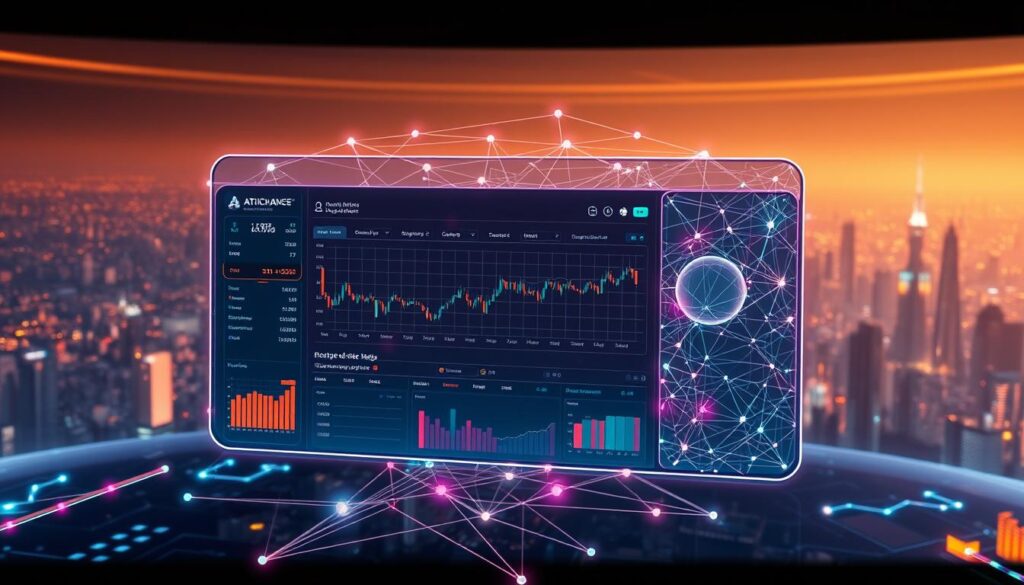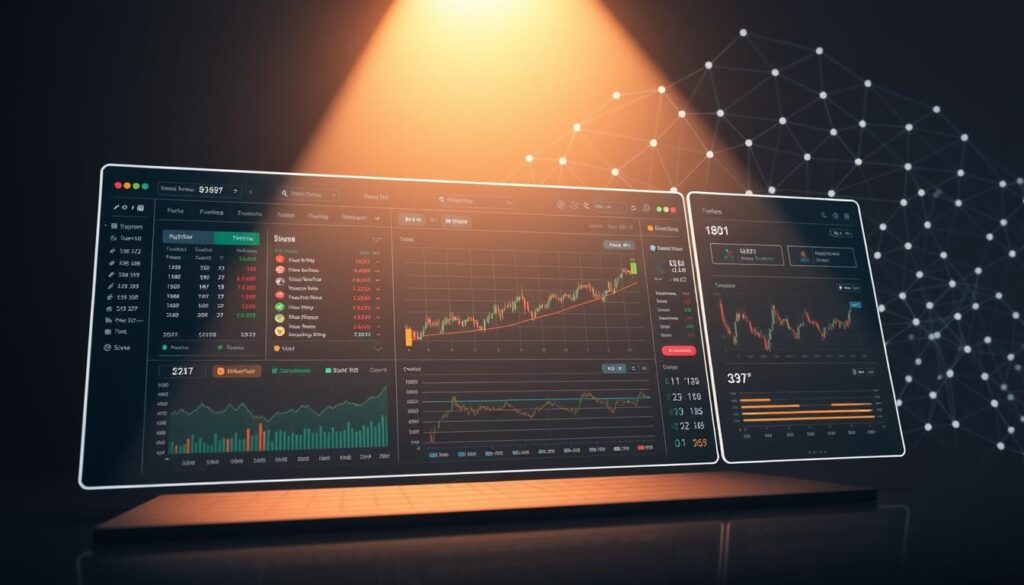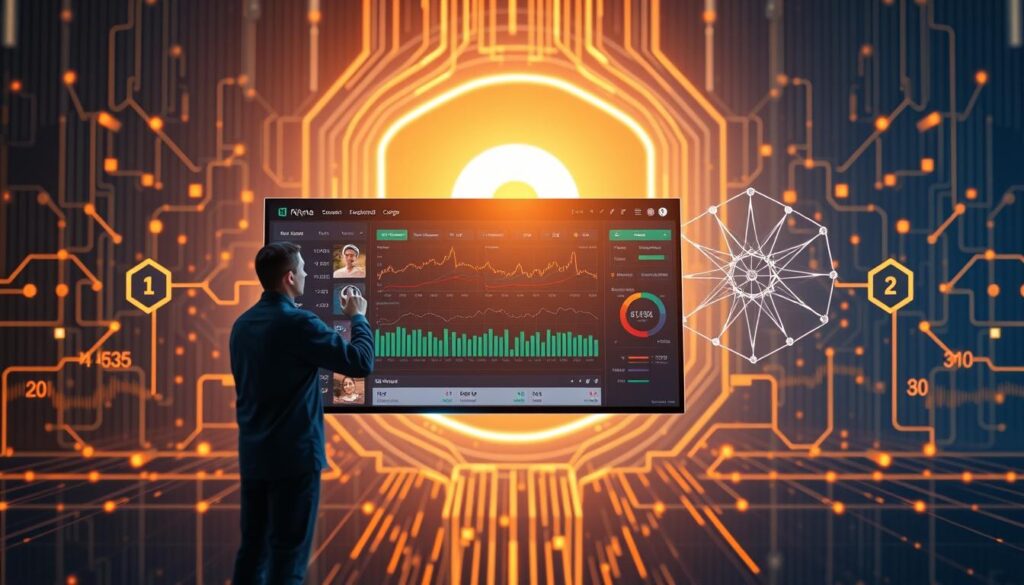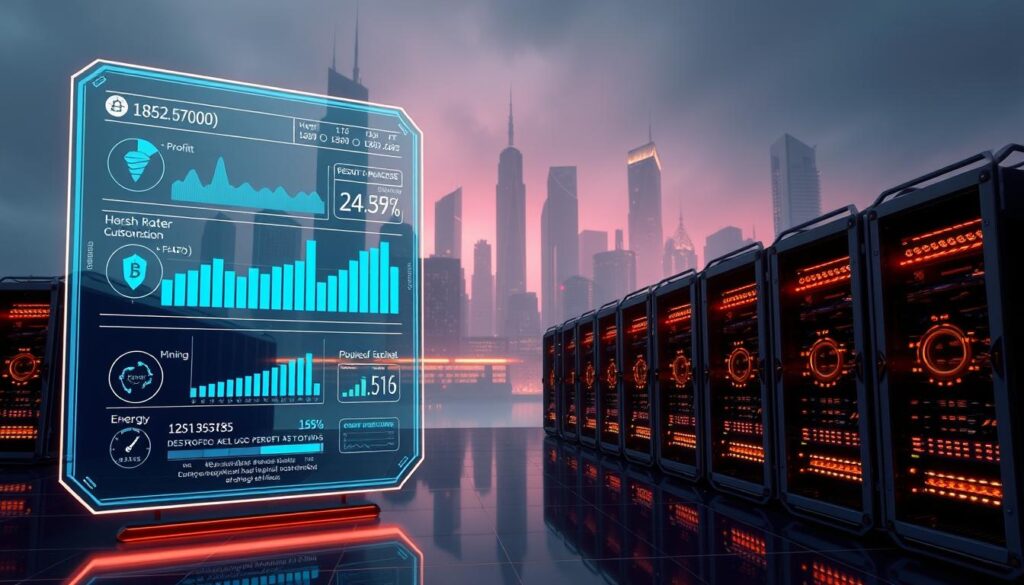Now Reading: AI Powered Decentralized Exchange Aggregators: A Trading Solution
- 01
AI Powered Decentralized Exchange Aggregators: A Trading Solution
AI Powered Decentralized Exchange Aggregators: A Trading Solution

The cryptocurrency market has transformed how people trade digital assets. Yet, finding the best prices across different platforms remains a challenge for many traders. This fragmentation creates inefficiencies that cost time and money.
Modern technology now offers a powerful solution to this problem. Advanced systems scan multiple venues simultaneously, identifying optimal execution points automatically. This eliminates the manual work of checking each platform separately.
These intelligent platforms analyze vast amounts of market data in real-time. They ensure traders access the deepest liquidity pools available. The result is better pricing and faster execution across the entire crypto ecosystem.
This guide will explore how these systems work and their benefits for United States-based traders. We’ll examine key features, compare leading platforms, and discuss implementation strategies. Understanding this technology is essential for capitalizing on today’s dynamic crypto market opportunities.
Key Takeaways
- Modern trading platforms solve liquidity fragmentation across multiple venues
- Automated systems scan markets in real-time for optimal pricing
- Traders save time by eliminating manual price comparisons
- Access to deeper liquidity pools improves execution quality
- These solutions are essential for competitive cryptocurrency trading
- United States traders can benefit from advanced execution technology
- Understanding platform features helps maximize trading performance
Introduction to AI Powered Decentralized Exchange Aggregators
Modern trading solutions have emerged to address the fragmentation in digital asset markets. These blockchain-based tools connect traders with multiple venues simultaneously. They scan various sources to find optimal pricing and lowest fees.

These intelligent systems function as intermediaries that analyze numerous platforms in real-time. They identify the best trading routes with minimal slippage. This automated approach saves significant time for crypto investors.
The DeFi market demonstrates massive growth potential for these technologies. Valued at $13.61 billion in 2022, projections show 46.0% annual growth through 2030. This expansion creates substantial opportunities for both platform developers and users.
| Market Metric | 2022 Value | Projected Growth |
|---|---|---|
| Global DeFi Market Size | $13.61 billion | 46.0% CAGR (2023-2030) |
| DEX Trading Volume (Q2 2024) | $370.7 billion | 15.7% quarterly increase |
| Platform Adoption Rate | Growing rapidly | Institutional interest rising |
Instead of checking individual venues manually, traders access aggregated liquidity through one interface. This unified approach provides better execution across the entire ecosystem. The technology serves both retail and institutional trading needs effectively.
The Evolution of DEX Aggregators in the DeFi Landscape
Financial technology innovation has progressively moved control from institutional intermediaries to individual users. This shift created new opportunities in the digital asset landscape.
From Traditional Trading Platforms to Decentralized Solutions
Early crypto exchanges operated like traditional financial institutions. They maintained custody of user funds and imposed various restrictions.
This centralized approach created demand for more efficient solutions. Users sought platforms that returned control to individual traders.

The DeFi market surpassed $50 billion in total value locked during 2023. This milestone demonstrated mainstream adoption of decentralized infrastructure.
The Role of AI in Reinventing Trade Execution
Machine learning algorithms transformed basic price comparison tools. They evolved into sophisticated systems capable of predictive analytics.
These advanced platforms process vast datasets in milliseconds. They analyze historical trends and current market conditions across multiple venues.
With projected annual growth rates exceeding 40%, intelligent systems represent a fundamental reinvention of trade execution. Modern traders face complex conditions where manual analysis proves insufficient.
| Evolution Stage | Traditional Platforms | Modern Solutions |
|---|---|---|
| User Control | Custodial funds | Self-custody |
| Market Access | Limited venues | Multiple exchanges |
| Execution Speed | Manual processes | Real-time optimization |
| Liquidity Access | Fragmented pools | Aggregated sources |
This evolution benefits the entire crypto ecosystem. It provides better pricing and efficiency for United States traders navigating today’s dynamic market.
Core Features of AI powered decentralized exchange aggregators
The operational backbone of modern trading platforms lies in their core functionality and intelligent systems. These sophisticated features handle complex market conditions automatically. They provide significant advantages for digital asset trading.

Smart Order Routing and Dynamic Liquidity
Smart order routing represents a fundamental advancement in execution technology. This system analyzes multiple venues simultaneously to identify optimal paths.
The algorithm considers various factors including liquidity depth and transaction costs. It automatically splits large orders across different pools to minimize market impact.
Dynamic liquidity aggregation ensures access to the deepest available pools. This platform capability allows traders to execute substantial volumes efficiently.
Real-Time Data Analysis and Price Discovery
Continuous market scanning enables accurate price discovery across integrated venues. The system processes vast amounts of data in milliseconds.
Real-time analysis identifies pricing discrepancies and emerging opportunities. This ensures users receive competitive rates unavailable on single exchanges.
Advanced trading systems incorporate additional functionality for comprehensive market coverage. These include cross-chain capabilities and customizable alert systems.
| Feature Category | Primary Function | User Benefit |
|---|---|---|
| Order Routing | Optimizes execution path | Reduces slippage and costs |
| Liquidity Access | Aggregates multiple sources | Enables larger trade sizes |
| Price Discovery | Scans all connected venues | Ensures best available pricing |
| Data Processing | Analyzes real-time information | Identifies emerging opportunities |
These core features create a robust foundation for effective digital asset trading. They represent the essential components that distinguish advanced platforms from basic tools.
Enhancing User Experience and Security
Successful trading platforms prioritize both accessibility and asset protection as fundamental requirements. These systems must simplify complex financial concepts while ensuring complete safety for user funds.

The combination of intuitive design and robust security creates the foundation for mainstream adoption. This approach builds essential trust among both novice and experienced traders.
Intuitive Interfaces and Customizable Dashboards
Modern platforms feature interfaces that make complex trading accessible to everyone. Users can personalize their dashboards to display preferred metrics and trading pairs.
This customization enhances the overall user experience by tailoring the platform to individual needs. Real-time insights help users make informed decisions quickly.
Robust Security Measures and Fraud Detection
Advanced systems continuously monitor for vulnerabilities and suspicious activities. They provide real-time risk assessments to protect against threats.
These security features work alongside comprehensive asset protection protocols. Over 75% of financial companies now use similar technologies for operations.
The result is a secure trading environment that gives users confidence in their financial activities. This level of protection is essential for widespread adoption.
Dynamic Liquidity and Optimal Pricing Strategies
Sophisticated liquidity management represents the next evolution in digital asset trading platforms. These systems dynamically reallocate resources across multiple venues to ensure efficient order execution. This approach maintains performance even during volatile market conditions.
Platforms like Matcha demonstrate this capability by sourcing liquidity from various pools. They continuously monitor depth across all integrated exchanges. The system automatically routes orders through the most liquid pathways.
This dynamic approach significantly reduces slippage for users. Large orders split across multiple sources rather than executing through single pools. Traders receive prices closest to current market rates with minimal price impact.
Optimal pricing strategies balance multiple variables beyond simple quoted prices. The platform considers transaction fees, gas costs, and execution speed. This comprehensive analysis reveals the true expense of each trading option.
| Strategy Component | Function | Benefit to Users |
|---|---|---|
| Dynamic Liquidity Allocation | Reallocates resources in real-time | Maintains efficiency during volatility |
| Multi-Pool Order Splitting | Distributes trades across venues | Reduces slippage on large orders |
| Total Cost Calculation | Accounts for hidden expenses | Provides transparent pricing |
| Continuous Market Monitoring | Scans liquidity depth constantly | Ensures optimal execution paths |
These strategies provide substantial advantages in today’s dynamic market. They offer transparent cost analysis that manual comparisons often miss. The system learns from patterns to anticipate where liquidity will be most available.
Integrating AI and Blockchain Technologies
The fusion of machine learning capabilities with cryptographic networks represents a breakthrough in trading efficiency. This powerful integration creates capabilities that neither technology could achieve independently.
Intelligent systems work seamlessly with distributed ledger technology to deliver superior results. The combination provides both security and advanced functionality.
Automated Trading Strategies and Predictive Analytics
Sophisticated algorithms execute complex strategies like arbitrage and market-making. These automated systems identify price differences across venues faster than human traders can react.
Predictive analytics examine historical patterns and current market data. Platforms use machine learning models to forecast price movements accurately.
This approach helps mitigate risks while optimizing trading outcomes. The intelligent analytics process vast amounts of market data in real-time.
Interoperability Across Multiple Blockchain Networks
Modern platforms enable trading across various distributed ledger systems. This cross-chain functionality connects different blockchain networks seamlessly.
Users can access liquidity from Ethereum, Solana, and other major blockchain networks. The technology eliminates manual bridging requirements between different blockchain environments.
This comprehensive approach creates a unified trading ecosystem. The strategic integration delivers both security and intelligence.
Comparing Leading DEX Aggregator Platforms
Different trading scenarios demand specialized features that vary across available platforms. United States traders should evaluate several key factors when selecting their primary trading tool.
Platform Overviews: 1Inch, CoW Swap, ParaSwap, and Cetus
The 1inch Network handles substantial trading volume exceeding $1.2 billion. Its Pathfinder algorithm optimizes routes across multiple exchanges.
CoW Swap uses unique batch auction protocols for peer-to-peer settlement. This approach reduces front-running risks for traders.
Rubic simplifies cross-chain operations across various blockchain networks. It offers zero protocol fees for smaller transactions under $100.
ParaSwap provides competitive rates through developer-friendly APIs. The platform integrates easily with external wallets and services.
Cetus demonstrates remarkable scale with $68 billion in trading volume. Its hybrid model combines multiple liquidity sources effectively.
Key Pros and Cons for Traders
Each platform serves distinct trading needs with specific advantages:
- 1inch: Excellent for Ethereum-focused trading with strong MEV protection
- CoW Swap: Ideal for larger orders benefiting from batch auction protocols
- Rubic: Best for cross-chain operations across different networks
- ParaSwap: Perfect for developers needing wallet integration capabilities
- Cetus: Superior for high-volume trading requiring deep liquidity
Traders should match their specific requirements with each platform’s strengths. The right choice depends on transaction size, network preferences, and desired features.
Cost and Development Considerations for DEX Aggregators
Building a competitive trading platform requires careful financial planning and strategic development decisions. Entrepreneurs must understand the investment range from $10,000 to $100,000 depending on complexity. This business planning phase establishes the foundation for successful platform creation.
The initial research and planning stage typically costs $2,000-$5,000. This covers market analysis, feasibility studies, and legal compliance assessment. Proper planning prevents costly mistakes during later development phases.
Budgeting and Feature Prioritization
Front-end development expenses range from $5,000 to $15,000 for interface design. Back-end development costs $10,000-$25,000 for smart contracts and blockchain integration. These technical components form the platform’s operational backbone.
Core features like smart order routing cost $3,000-$10,000 each to implement. Additional features such as analytics dashboards add $2,000-$10,000 per capability. Developers must prioritize essential functions before adding advanced options.
| Development Phase | Cost Range | Key Components |
|---|---|---|
| Research & Planning | $2,000-$5,000 | Market analysis, legal compliance |
| Front-End Development | $5,000-$15,000 | UI/UX design, responsive interfaces |
| Back-End Development | $10,000-$25,000 | Smart contracts, API integration |
| Testing & QA | $2,000-$5,000 | Security audits, user acceptance testing |
Quality assurance and testing require $2,000-$5,000 to ensure platform reliability. Monthly maintenance costs $1,000-$5,000 for updates and monitoring. This ongoing investment keeps the platform competitive in dynamic markets.
Strategic feature prioritization helps businesses manage costs effectively. Developers should focus on core functionality before expanding feature sets. This approach controls initial development expenses while building a solid foundation.
Market Trends and Future Growth in DeFi Trading
Financial markets continue evolving with remarkable speed, particularly in the digital asset space. The trading landscape demonstrates unprecedented growth with substantial market expansion.
Recent data reveals the crypto sector’s impressive trajectory. The DeFi market reached $13.61 billion in 2022 with 46.0% annual growth projected through 2030.
This sustained expansion indicates deep-rooted development rather than temporary speculation. The future appears bright for sophisticated trading platforms.
Decentralized platforms recorded $370.7 billion in spot trading volume during Q2 2024. This represents a 15.7% quarterly increase, showing accelerating adoption.
| Market Segment | Current Value | Growth Indicator |
|---|---|---|
| DeFi Market Size | $13.61 billion (2022) | 46.0% CAGR (2023-2030) |
| Spot Trading Volume | $370.7 billion (Q2 2024) | 15.7% quarterly increase |
| AI-Crypto Sector | $24.63 billion market cap | 92 total assets |
The convergence of advanced technologies creates new potential for investors. This sector commands approximately $17.34 billion in specialized assets.
Multiple factors drive continued growth including institutional adoption and regulatory clarity. Technological improvements enhance blockchain scalability and user experience.
These platforms position themselves as the future of digital asset trading. Early movers can capture significant market advantages as the ecosystem matures.
Navigating the Decentralized Finance Ecosystem
Insurance mechanisms are transforming risk management within the financial landscape. These protections address wallet security issues and smart contract vulnerabilities effectively.
The interconnected ecosystem combines various protocols and liquidity pools. This creates comprehensive infrastructure without traditional intermediaries.
Impact on Trading Volume and Liquidity Access
Consolidated platforms increase available liquidity significantly. They channel transactions through multiple pools simultaneously.
This approach benefits both traders and liquidity providers. Better access drives higher trading volume across the entire market.
Risk mitigation tools attract institutional participants to the ecosystem. Enhanced security builds confidence for larger transactions.
Understanding these dynamics helps traders optimize their market participation. Strategic access to liquidity improves overall trading outcomes.
Practical Tips for Traders and Entrepreneurs
Navigating today’s dynamic trading environment demands practical insights that bridge user experience and business development. Both active traders and platform creators need strategic approaches for sustainable success.
Strategies for Maximizing Trade Efficiency
Experienced traders integrate their preferred wallets like MetaMask or Ledger for optimal security. These essential tools maintain private key control while accessing advanced functionality.
Smart timing reduces costs during lower network congestion periods. Splitting large orders across multiple transactions can improve execution quality significantly.
Best Practices for DEX Aggregator Adoption
New users should start with smaller test transactions to understand platform mechanics. Gradually explore advanced features as confidence grows with these powerful tools.
Entrepreneurs can build scalable business opportunities through comprehensive platform development. Specialized services targeting specific market niches often deliver better results.
| User Type | Primary Focus | Key Success Factor |
|---|---|---|
| Active Traders | Execution efficiency | Wallet integration & timing |
| New Users | Platform familiarity | Gradual feature exploration |
| Entrepreneurs | Business development | Niche specialization |
Mastering these platforms separates amateur participants from professional-level performers. Proper implementation ensures long-term success in the evolving financial landscape. For comprehensive guidance on platform development, explore this detailed development resource.
Conclusion
The evolution of financial tools continues to transform the landscape for cryptocurrency participants. Modern systems address previous limitations through sophisticated technology that delivers measurable benefits across the entire ecosystem.
These advanced platforms significantly improve the user experience while enhancing market efficiency. Traders gain access to better pricing and reduced transaction costs through intelligent routing systems.
The growing cryptocurrency sector presents substantial opportunities for both individual traders and platform developers. Early adoption provides competitive advantages in this rapidly expanding market.
While challenges remain, the trajectory clearly points toward these systems becoming essential infrastructure. Their continued development promises even greater accessibility and efficiency for global trading communities.
Success in today’s dynamic environment requires embracing innovative solutions that optimize performance. The future of digital asset management lies in technologies that combine security with intelligent functionality.
FAQ
What is a DEX aggregator and how does it improve my trading?
A DEX aggregator is a platform that scans multiple decentralized exchanges simultaneously to find you the best possible price for your trade. It saves you time and money by automatically comparing prices and routing your transaction through the most efficient path, maximizing your trade efficiency.
How does artificial intelligence enhance these platforms?
Artificial intelligence improves these platforms by using predictive analytics to forecast price movements and optimize trade execution. It analyzes real-time data across different blockchain networks to execute orders at the most favorable rates, enhancing the overall user experience.
Are my funds secure when using a DEX aggregator?
Yes, security is a top priority. These platforms operate using non-custodial smart contract protocols, meaning you retain control of your assets in your own wallet. They also incorporate advanced fraud detection systems to protect users from malicious activity.
Can I use these tools on any blockchain?
Many leading aggregators support interoperability across several major blockchain networks, such as Ethereum, Polygon, and Arbitrum. This functionality allows traders to access a wider pool of liquidity and tokens from different ecosystems.
What are the main benefits for a cryptocurrency trader?
The primary benefits include better pricing through dynamic liquidity access, reduced slippage via smart order routing, and significant time savings. These features collectively lead to improved profitability and a more streamlined trading process.
How do platforms like 1inch and ParaSwap differ?
While both aim to provide optimal pricing, they may differ in their supported networks, fee structures, and additional features like built-in analytics tools or integration with specific wallets. It’s best to test different platforms to see which aligns with your specific trading needs.















